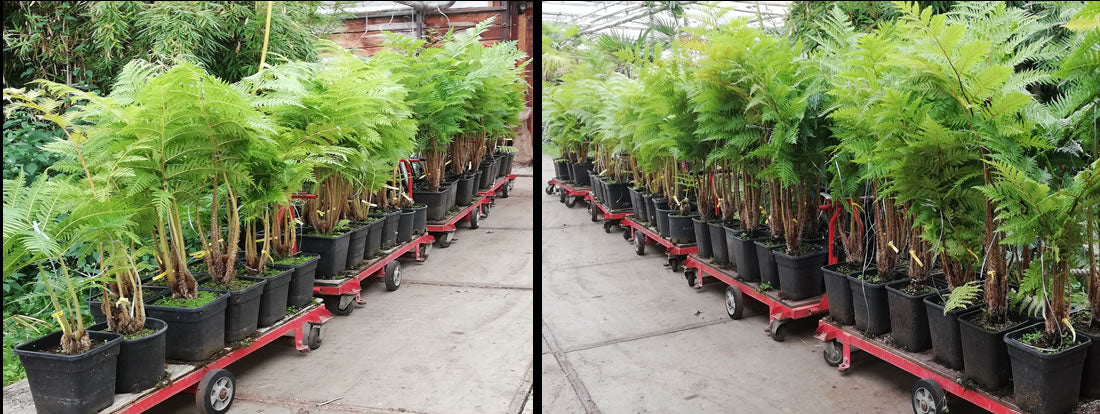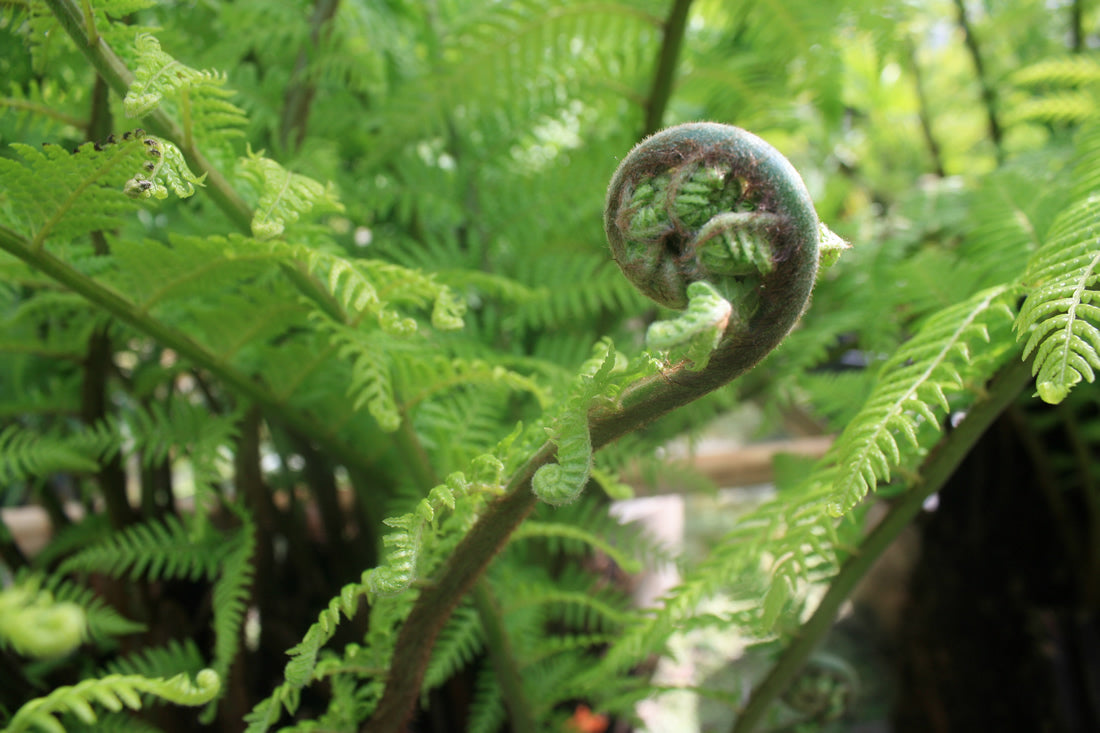

About tree ferns:
Treeferns grow scattered over a big area of the world. They derive from the time of the dinosaurs! Back then they were found all over the world. The most well-known families are Dicksonia and Cyathea.
The most well-known species in our country are Dicksonia Antarctica and Dicksonia Fibrosa, which are also suitable for outside. They have their origin in the highlands of Tasmania and New-Zealand in a cool sea climate on a height of 300-1000 meter. They can withstand frost, although this cold period is shorter than our winters. They prefer shade, but with sufficient water they also can withstand sunny locations.
Growing habits and watering
The trunk of the Dicksonia tree ferns consists totally in living roots and the growing point is on top of the crown. Therefore in the country of origin they can be saw off right above the ground, and transported with all leafs taken off. Rerooting in our facilities takes place by watering the whole trunk and the crown in particular. Therefore a Dicksonia tree fern will always fit in your conservatory: you can saw off the trunk on every height you wish. The upper part with the crown can be planted again and will reroot, the lower part will die. After reading this, you will under-stand the need of watering the roots in the trunk.
The Cyathea tree ferns have to be imported with roots. They need their roots underground, as they can only make limited use of the roots in the trunk.
You can assume that you never can water a well rooted tree fern too much, because the water will be carried off along the trunk. As this trunk consists of roots and humus, you need to water all tree ferns, including the Cyathea families from above in the crown, so that the trunk stays moist. A watering installation in your garden would be the easiest.
Almost none water should be given under the following circumstances:
1. when the tree ferns has no leaves. The leaves also evaporate a lot of the superfluous water
2. when the tree fern has none or almost no roots.
3. when the temperature is very low, how colder the less or none water.
Above mentioned items are a matter of instinct, dependant of the size of the plant, place and temperature. Recommendations are to moisture only the outside or 1 or 2 times per week 2 liter water.
Leaves
In 3 to 8 weeks (after import) the first fronds will grow from the crown, which are almost full grown. In the spring the fronds will appear with 10 to 30 simultaneously, dependent of the trunk size and specie. Individual fronds will appear during the whole year. Dehydrated fronds have to be cut off 10 cm above the trunk, this will stimulate the growth of new leaves.
The trunk
In our climate as well as in their natural habitat, Dicksonia trunks only grow 2-4 cm per year, dependent of the specie and their place. So a reasonable trunk can already be 50 to 100 years old. Cyathea species like Cyathea medullaris and Cyathea cooperi grow faster, approximately 15-20 cm per year.
The roots and fertilizer
The relation between the roots and the trunk size is less important with tree ferns than with other plants. Although small plants like bigger pots, they will grow better and faster. After planting, the roots will develop fast, it will take max. 8 weeks.
The trunk exists of a network or roots which are important for the nourishment. The plant will grow bigger leaves, if you water with solvable fertilizer to the water (dilute twice as much as the instructions says) in the crown in springtime repeatedly every 6 weeks, till end of July. After that the plant will prepare for winter.
Temperature
In the natural habitat of the Dicksonia Antarctica and Dicksonia Fibrosa temperature varies between -13°C en +35°C. In our climate, temperatures till -5°C can easily be withstand when planted outside and/or solitaire, under the condition that the trunk is well rooted. My experience is that freezing temperatures of -10°C at night with day temperatures above 0°C, can be survived even without protection. Most of the Cyathea species are only suitable for pots, best winter temperature is 12°C, but it is possible to winter them by 3 to 5°C.
Inside or outside
All tree ferns species are suited for a tub or planted in a conservatory. In-house is not recommended, because they need a high humidity.
For the adventurers there are possibilities for outside, like the well known Dicksonia Antarctica and Dicksonia Fibrosa and the less-known Dicksonia Sellowiana (to my experience even hardier than the Dicksonia Antarctica). Also possible are the Cyathea species: Dregei, Australis, Smithii and Dealbata. Slower grow and smaller fronds have to be taken into consideration and there will always be a risk.
Tree ferns and winter protection
Precautions for temperatures around -5°C and colder coming up: in its natural habitat the shape of the fronds forms a funnel for fallen leaves from trees in the surrounding. The compost leaves work like isolation during the winter months and in the spring they will be pushed out by the new fronds.
You can easily copy this process by hand, by placing leaves or straw in the crown, preferably in the autumn.
Bind the leaves together and wrap 4 layers of fleece around the leaves and the trunk. Per layer the frost will be reduced with several degrees.
A young tree fern can be covered with straw and leaves totally. Do not remove the fronds, the more fronds are on the plant in the spring, the stronger the plant will be to grow new fronds in the spring.
When the temperature allows it, unpack the tree fern, otherwise it can dehydrate.
By an older tree fern only the crown needs to be wrapped with fleece, as this is the most vulnerable part of the plant. You can leave this fleece the whole winter.
The trunk can be wrapped more flexible when it gets real cold, but not the whole winter because it needs to be moistured and should not dehydrate.
Planting possibilities
Airy and compost ground stimulates the rooting of the trunk. As an alternative you can use universal pot ground, mixed with perlite or Portuguese bark of the Pinus Maritime (no normal bark). General rule by Dicksonia’s is that ¼ of the trunk is put in the ground. By big sizes exceptions can be made, under the condition that the plants stands stable enough.
© Copyright Tropical Centre. All rights reserved.
